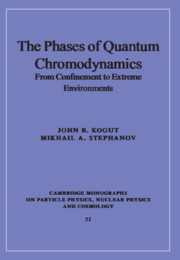Book contents
- Frontmatter
- Contents
- 1 Introduction
- 2 Background in spin systems and critical phenomena
- 3 Gauge fields on a four-dimensional euclidean lattice
- 4 Fermions and nonperturbative dynamics in QCD
- 5 Lattice fermions and chiral symmetry
- 6 The Hamiltonian version of lattice-gauge theory
- 7 Phase transitions in lattice-gauge theory at high temperatures
- 8 Physics of QCD at high temperatures and chemical potentials
- 9 Large chemical potentials and color superconductivity
- 10 Effective Lagrangians and models of QCD at nonzero chemical potential
- 11 Lattice-gauge theory at nonzero chemical potential
- 12 Epilogue
- References
- Index
8 - Physics of QCD at high temperatures and chemical potentials
Published online by Cambridge University Press: 17 August 2009
- Frontmatter
- Contents
- 1 Introduction
- 2 Background in spin systems and critical phenomena
- 3 Gauge fields on a four-dimensional euclidean lattice
- 4 Fermions and nonperturbative dynamics in QCD
- 5 Lattice fermions and chiral symmetry
- 6 The Hamiltonian version of lattice-gauge theory
- 7 Phase transitions in lattice-gauge theory at high temperatures
- 8 Physics of QCD at high temperatures and chemical potentials
- 9 Large chemical potentials and color superconductivity
- 10 Effective Lagrangians and models of QCD at nonzero chemical potential
- 11 Lattice-gauge theory at nonzero chemical potential
- 12 Epilogue
- References
- Index
Summary
The thermodynamic background
Let's begin our discussion of QCD in extreme environments that are rich in baryons by reviewing some basic concepts of thermodynamics. We want to remind the reader of the partition function, its relation to Euclidean field theory, and the physics and formalism of the chemical potential in simple settings. These discussions will set the stage for more-challenging applications to QCD.
The reader should appreciate that QCD is a remarkable, yet frustrating theory. On the one hand, we know the theory's “first principles” thoroughly, in the sense that we have a well-defined prescription for calculating any quantum-mechanical amplitude governed by strong interactions. The principles are simple and beautiful. However, the phenomena which result from application of these principles are very complicated. For example, asymptotic freedom indicates that a natural language, both for physical ideas and for quantitative estimates, for the short-distance behavior of QCD is that of weakly interacting quarks and gluons. For larger distances and times, this description becomes inadequate in several ways. First, the running coupling grows large and perturbative estimates are no longer reliable. Second, the assumption that physical quantities should be analytic functions of the coupling becomes untenable. Quarks and gluons are not weakly fluctuating degrees of freedom at these length scales. Other dynamical variables, perhaps instantons, color-bearing monopoles, and flux tubes, provide a more relevant description of the physics. These facts indicate that reliable calculations in QCD are beyond our existing mathematical abilities.
- Type
- Chapter
- Information
- The Phases of Quantum ChromodynamicsFrom Confinement to Extreme Environments, pp. 182 - 235Publisher: Cambridge University PressPrint publication year: 2003



